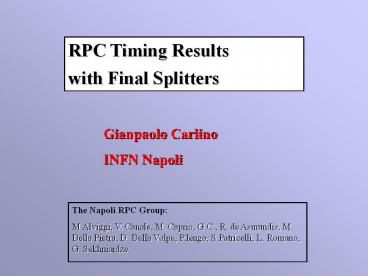Test Station (1) PowerPoint PPT Presentation
1 / 27
Title: Test Station (1)
1
RPC Timing Results with Final Splitters
Gianpaolo Carlino INFN Napoli
The Napoli RPC Group M.Alviggi, V. Canale, M.
Caprio, G.C., R. de Asmundis, M. Della Pietra, D.
Della Volpe, P.Iengo, S.Patricelli, L. Romano, G.
Sekhniaidze
2
Outline
- Napoli Test Station
- Efficiency and Multiplicity Measurements
- RPC Time Distributions with Final Splitters
- Comparison between Standard and Wired OR Strip
Readout as a function of threshold - Conclusions
The Final Splitter in the one designed in Roma
1. It will be used on the experiment but not in
the RPC tests
3
The Test Station
3.5 m
4
The Drift Chambers
Each chambers has 2 X layers and 2 Y layers
Golden Event Fully Reconstructed Tracks with 1
hit per layer (50 Selection Efficiency)
5
(No Transcript)
6
(No Transcript)
7
(No Transcript)
8
(No Transcript)
9
(No Transcript)
10
Experimental Setup
RPC type BOS - B 004
Working Point HV 10.500 V Threshold 0.59 mV
11
Some Definitions
Physical Strip Fired Strip corresponding to the
Expected Strip
Physical Cluster Cluster with the Physical Strip
Expected Strip Strip given by the Impact Point
of the Track on the RPC surface
Efficiency Event with a Physical Strip
12
Strip Av. Multi 1.58
RPC Multiplicity for Strips and Clusters
Cluster Av. Multi 1.08
13
Physical Clusters Av. Size 1.57
Cluster Sizes
Other Clusters Av. Size 1.11
14
RPC Efficiency as a function of Strips
Efficiency 0.960
In the definition of the efficiency we use a
tolerance of ? 5 mm
Inefficiency
Spacers
We expect to improve the efficiency with a more
precise RPC alignment (under study)
15
Tracks Impact Points of the RPC Surface for
Inefficient Events Spacers
16
RPC Times Distribution
Multi-hit TDC
More than one Pulse could be recorded for each
Strip
Peak 1
Peak 2
The Trigger Logic could be in trouble because of
the presence of more than one pulse from the same
strip. Trigger People are able to solve this
problem
Peak 3
17
- RPC Time - Percentage of Peaks presence as a
function of the threshold
Peaks 12
Only Peak 1
All Peaks
Physical Strip ONLY !!
18
- RPC Time - Percentage of Peaks presence as a
function of the threshold
Only Peak 1
Peaks 12
All other Strips in the Physical Cluster
All Peaks
19
RPC Times Pulse Widths
- Peak 1 -
Longer Widths could be obtained with a
modification of the Front End Electronic
20
Pulse Width Distributions
Average pulse width is about 8 ns. Some channels
show shorter pulses. Lets divide strips in two
categories Long and Short Pulse Strips
Short
Long
Short
Example of Pulse Widths for 2 Strips
Short
Long
21
- RPC Times
- Time Difference between Physical and Other Strips
Physical Clusters
- Peak 1 -
Other Clusters
The Large Time Difference between strips in the
same cluster must be taken into account for the
declustering algorithm and the bunchlet
identification
22
Size 2
RPC Times - Peak 1
Time Difference between Physical and neighbor
Strips as a function of the Cluster Size
Size 3
Size 4
Only Physical Cluster Strips
23
D 1
RPC Times - Peak 1
Time Difference between Physical and neighbor
Strips as a function of Strip Distance (D)
D 2
D 3
Only Physical Cluster Strips
24
Comparison between Standard and Wired OR Strip
Readouts as a function of Threshold
Standard Readout
Final Splitter
TDC
j - Strips
Wired OR Readout
Final Splitter
TDC
Will be used for f strips
25
Multiplicities Comparison as a function of the
threshold
Cluster Sizes Comparison
26
Efficiency Comparison with Wired - OR as a
function of the threshold
Wired - OR
The efficiency loss in the Wired OR Readout could
be reduced with a precise tuning of the threshold
27
Conclusions
- The results of a test performed on 32 f strips of
a BOS RPC have been shown. - The RPC Efficiency and Multiplicities are in
agreement with expectations. - Timing Results
- The presence of more than one pulse per strip has
to be taken into account in the trigger logic. - Some modifications of the Front End Electronics
are needed in order to get longer strip pulses. - The difference in the time response of strips
belonging to the same cluster needs a more
detailed study and an adequate simulation in the
Trigger Simulation Program. - The analysis will be repeated (and this results
confirmed) with larger statistics as soon as we
will have in Napoli more chambers and splitters
to test.

